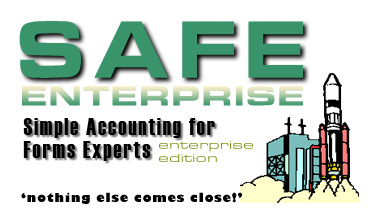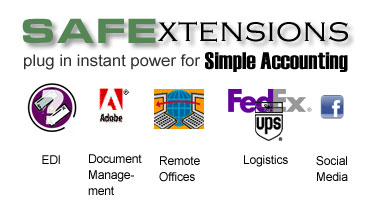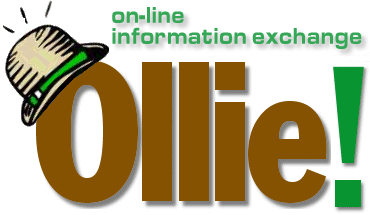Fields
| DESCRIPTION | A forty character description of the product or service.
12X8-1/2 1PT BLANK 20LB. CLEAN PERF |
| CUSTOMER ID | This allows you to associate a form with a particular customer and must be a valid ID from your Customer Browse. If you enter a Customer ID in this field you will only be allowed to use this product with orders with that particular Customer (or Corporation if that customer is assigned a Corporate ID.) |
| PRODUCT TYPE ID | Select a valid ID selected from the Product Typesbrowse using the field lookup button. A product type performs several extremely important functions related to this data file:1. It allows the system to track sales by Product Type.
2. It is the link between this program and your Chart of Accounts. All transactions using a product ID are posted to the revenue and expense accounts associated with the product ids product type. 3. It determines which type of Spec Sheet will be used for data entry and for printing purchase orders and RFQs. This allows you to print custom POs for labels, envelopes, etc. 4. It automatically enters a suggested unit sale price of an item once you enter the unit cost. This is the unit cost plus the Profit Percentage field entered for the selected Product Type. |
| FORM NUMBER | Enter the customer’s product ID for this product or service. Unlike the Product ID, you can re-use the same Form Number for as many customers as you like, so long as you do not try to use the same Form Number more than once for a single customer. |
| PRODUCT ID | The ID used to identify this item throughout Simple Accounting. This must be unique. Simple Accounting can automatically assign a default Product ID for you based on your selections in FILES|Setup Global Options. using a combination of FORM NUMBER, CUSTOMER ID, PRODUCT TYPE or a number. |
| VENDOR ID | This must be a valid ID selected from the FILES|Vendors. Press the field lookup buttonto select from the vendors browse. You may override this field during order entry with another valid vendor ID, but each item on each order must contain a valid vendor ID. This allows Simple Accounting to track sales by vendor and customer.
If this is a finished good, you may wish to use your Company Customer/Vendor ID here. This prevents Simple Accounting from posting costs from sales of the product to A/P under any circumstances. |
| VENDOR PRODUCT ID | Enter the vendor’s stock number for this product, if applicable. This can print on purchase orders to help the vendor cross-reference your Product ID. If your company is the service provider, then set up your own company as a vendor and use that ID. |
| MAIN BIN/LOCATION | Enter an eight digit ID indicating the storage location (bin) for this form. You may use any nomenclature you wish. This allows you to prepare lists of items for multiple locations, either for your own stock, or for warehoused forms for customers with multiple locations. |
| CATEGORY #1 | This field allows you to further organize each Product ID. Use it for sorting or filtering records on reports and browses. Simple Accounting does not use this field for processing.Category fields are also used to make selecting a Product easier in Ollie or WebSAFE. |
| CATEGORY #2 | Similar to CATEGORY #1. This field allows you to further organize each Product ID. Use it for sorting or filtering records on reports and browses. Simple Accounting does not use this field for processing. |
| CATEGORY #3 | Similar to CATEGORY #1. This field allows you to further organize each Product ID. Use it for sorting or filtering records on reports and browses. |
| CATEGORY #4 | Similar to CATEGORY #1. This field allows you to further organize each Product ID. Use it for sorting or filtering records on reports and browses.
You sell many different types of checks. You may set up the CATEGORY fields for these Products as follows:
12345-CK-C CHECK CUTSHEET LASER 12345-CK-I CHECK CUTSHEET INKJET 12345-CK-C CHECK CONTINUOUS 2-PART 12345-CK-C CHECK CONTINUOUS 1-PART |
| COMMISSIONS % | Assign a standard percentage to be paid to sales reps on profit generated from sales of this item. The Sales Commission Detail Report will show the suggested commission due on each line item sold using this percentage. Leave this field blank if you do not calculate commissions in this manner. This field is used for reporting purposes only. |
| INVENTORIED U/M | Enter the Unit of Measure you use to purchase this product from the Units of Measure Browse. This is the unit in which the product is inventoried (The default is 1000s.) |
| SELL/RELEASE U/M | Enter the Unit of Measure used when selling this product from the Units of Measure Browse. This allows you to buy in one unit and sell in another. |
| DEFAULT UNIT COST | The cost paid per unit to the vendor. This field becomes the default UNIT COST field under Sales Orders and Purchase Orders. The extended cost for a particular Line Item may either be a lot cost or a per-unit cost. This is determined, in all types of transactions and reports, by the COST TYPE field. This is not the same thing as the ACTUAL UNIT COST of an item which is discussed later. This field merely stores what will be plugged in as the default value in a Sales order or Purchase order. The difference is that the ACTUAL UNIT COST is calculated as you buy and sell things based on your settings for Cost of Goods in FILES|Setup Accounts Payable Options (LIFO, FIFO, Average). This is not the same thing as the ACTUAL UNIT COST of an item which is discussed later. This field merely stores what will be plugged in as the default value in a Sales order or Purchase order. The difference is that the ACTUAL UNIT COST is calculated as you buy and sell things based on your settings for Cost of Goods in FILES|Setup Accounts Payable Options (LIFO, FIFO, Average). |
| UNIT PRICE | The default sale price for this item. This defaults to the Unit Cost plus the profit percentage entered for the Product Type in FILES|Product TypesBrowseProductTypes~ProfitPercentage. You can also enter alternate prices in the Price Breaks list under the Links tab to facilitate quantity break pricing. |
| PACKAGE QTY | Select the quantity per package for the product using the Units of Measure Browse. This is different from the INVENTORIED QUANTITY in that this field may be used to indicate the number of packages (cartons, for example) used when counting items, or on sales orders to indicate to your customer how many cartons they are to receive. For example, you may purchase and pay for a product by the thousand (M) but wish to sell it by the carton at 2500 per carton. In that case, you would enter 2500 in this field. |
| PACKAGE U/M | An alternate unit of measure for delivery to customers. For example, you may purchase the product at a per thousand price but wish to sell by the carton. In that case, you would enter ‘CT’ in this field.
Neither of these two fields affects the calculation of revenues, costs, or inventory levels. They are made available only for display purposes. These PACKAGE quantities will only appear on invoices, P.O.s, etc. if your invoices are specially formatted by Suntower Systems using our Forms Design Service to provide this feature. Otherwise, these forms will print using the INVENTORIED U/M AND QUANTITY. |
| RECYCLABLE | Check this box if the product is recyclable. This can be especially handy for selling to clients who specify earth-friendly products. You can generate a list of only recyclable products using the filter available for Product IDs. |
| RECYCLED | Check this box if the product has recycled fibers in it. This can be especially handy for selling to clients or institutions that specify only earth-friendly products. |
| TAXABLE? | This checkbox sets the default for entering Sales Order Line Items. When left unchecked during order entry, the item is not taxed, regardless of the Sales Tax ID selected for the line item. Use this to prevent services and other non-taxable items from being accidentally taxed. |
| FMS? | Indicates whether or not this form is part of your forms management system.
This field is strictly for sorting purposes only and does not affect inventory or usage calculations at all. |
| SITE AUTO LINK? | Check this box if you want Simple Accounting to automatically link the Product to the selected Sites (Ship Tos/Ship Froms)as you create Sales Orders, Purchase orders and Counts. Leaving this unchecked forces users to manually link each Product to the Sites you wish to allow it to Ship To or Ship From.
This field defaults to being checked.
|
| SPEC STYLE | Overrides default Spec Type for the Product, which defaults to the Spec Type for the selected Product Type. |
Ordering Tab
This tab holds fields to help Simple Accounting track ordering and usage patterns for each product.
| PRODUCT IS OWNED BY | Determines whether on-hand quantities will be tracked and how. This is the default behavior for an item on each sales order, but you can override on a per order basis. In other words, you may have an item that you usually purchase for your inventory, but occasionally buy and ship directly to the customer. The choices are Distributor, Customer, Vendor, or N/A. |
| Distributor | Owned by your company. When you sell the item, the On Hand Quantity of the item is reduced by the quantity shipped. When you purchase the item on a Vendor P.O., the On Hand Quantity is increased.
Usage of Distributor owned items can be tracked by customer so long as you always indicate the proper Shipping Address (SITE) on sales orders. |
| Customer | Owned by your customer. When you sell the item, the item may be tracked at the customer site according to these rules:
|
| Vendor | This item is always bill as shipped. No inventory totals are updated for this item ever. |
| N/A | Not applicable. Use this for services and miscellaneous fees.
Alwaysselect N/A whenever the Product is not inventoried, including special services and miscellaneous charges. This speeds the execution of many transactions significantly! |
| ALLOW OVER RUNS? | Check this box to allow a Product to be overrun. Leave this box unchecked if you wish to prevent overruns. The default is checked.
This box is only form information purposes on purchase orders or RFQs. Leaving this box unchecked does not prevent users from receiving or shipping quantities greater than the quantity ordered. |
| ALLOW UNDER RUNS? | Check this box to allow a Product to be under run. Leave this box unchecked if you wish to specify that under runs are unacceptable. The default is checked.
Leaving this box unchecked automatically creates a back order when receiving in any quantity less than the ordered quantity on purchase orders or Sales Orders. |
| SPEC TYPE | This field overrides the default Spec Type selected with the Product Type. |
| USAGE CALCULATED BY | Determines whether sales invoices or counts are used to calculate inventory levels and usage for the Product. There are three choices. Each choice is indicated by an ID which prints on various reports:
You can change this field if necessary for reporting purposes. However, all usage history will be recalculated using the new method. |
| TYPE | CODE EXPLANATION |
| Current Sale: S | Each time you sell or release the item, the quantity shipped is considered to be quantity used. |
| Previous Sale: R | When you sell or release a product, the total quantity of the last shipment is considered used. |
| Counts C | Usage is calculated based on counts taken, either at your warehouse or at the customer site. Production orders are not considered part of usage. |
| N/A N | Disables all usage calculation for the product.
Select N/A whenever possible (such as for services or various added costs such as third -party labor) as it speeds up processing in Simple Accounting dramatically! |
| CALCULATE REORDER DATE? | Do you want Simple Accounting to automatically calculate when to reorder this product? If you do not click this field, then reorder notices are generated only when you enter one of the next two fields. |
| REORDER POINT | If the product is inventoried or warehoused, you can use this field to determine when to reorder. If the on hand quantity drops below this level, the product is flagged for reordering. Also, if the Ship Quantity on a sales order would bring the on hand quantity below this value, a warning message displays to prevent an overshipment.
Leave this field zero to disable this warning message. |
| REORDER LEAD TIME | The number of days lead time you would need to reorder this product before depletion. The default is 30. As an example, if Simple Accounting determines that the depletion date is 08/01/99 and you have the LEAD TIME field set to 30, then this product will be flagged for reordering on 07/02/99 to give you plenty of time to replenish stock before depletion. |
| REORDER HOW OFTEN | Enter a number of days. If this is an FMS form, you will be able to automatically generate reorder notices in FM HISTORY|Reorders based on this number. A reorder notice will be generated after this number of days has elapsed since the last order. |
| MONTHS TO STOCK | Enter the number of months worth of this product that should be available at all times. Simple Accounting uses this to determine how much, and when to, reorder the product. This should reflect the total of both the ON SITE and ON HAND quantities. |
| STORAGE FEE $/% | Enter a percentage of the on hand value (or a straight dollar amount) to be charge for warehousing this product. The actual calculation is stored in a formula determined in FILES|Setup Sales & A/R Options. You can then automatically generate Storage Fee Invoices every month based on the current quantities of all customer owned FMS products. |
| REORDER POINT | Enter a quantity (using the BUY/SELL unit of measure) below which the products total available quantity must not be allowed to fall. |
| STD ORDER QUANTITY | Sets the default quantity (using BUY/SELL unit of measure) to be ordered for purchase orders or RFQs of this product. |
| STD SELL QUANTITY | Sets the default quantity (using SELL unit of measure) to be shipped for sales or releases of this product. |
| MAX SHIP QUANTITY | Sets the maximum quantity (using SELL unit of measure) that may be entered as order or shipped on Sales Order Line Items of this Product. |
| LAST REVISION | Shows the last time any field in this screen was updated. However, using Security Extensions, you can disable this automatic updating and enter your own Revision Dates here. |
| LAST STARTING # | The starting number of the last order of this product. Whenever the product is sold, this field is updated with the new STARTING number from the sales line item. This lets you print the starting number of new orders and the starting number of the last order of this product on purchase orders. |
| NEXT STARTING # | The starting number for the next order of this product. On the next order, this will become the suggested STARTING number. After the next order is invoiced, this field is updated with the new NEXT STARTING NUMBER from the sales line item. The speeds reordering for your customer. |
| LAST VENDOR JOB ID | The job number from the vendor’s last order Number for the last order. |
| LAST SALES ORDER ID | The last sales order which used this Product. |
| F/M UNIT PRICE | This field represents the Unit Price by which your Customers value of the inventory is established. This may differ from the SELL UNIT PRICE. This is useful in situations where your customer has decided that his value of a particular item, on his General Ledger is arbitrarily different from the price originally paid for the Product. |
Notes Tab
| CUSTOMER | This field holds special customer instructions. These will appear on the customer invoice and packing slips. Any changes made to an item on an order are stored with that order, and may be reviewed under SALES HISTORY, but do not affect the notes originally entered here. |
| VENDOR | Calls up a separate NoteTaker to add special instructions to the vendor. These notes will appear on the vendor’s purchase orders. Any changes made to an item on an order are stored with that order, and may be reviewed under SALES HISTORY, but do not affect the notes originally entered here. |
| WARNING! | Calls up a third separate NoteTaker to add special instructions about this form for your own personnel. These are referred to as WARNING NOTES in the program. These notes appear in a box at the right of the data entry window. Use WARNING NOTES to enter special ideas to be noted when ordering but which should not appear on either the customer invoice or the vendor P.O. |
Links Tab
| PRICE BREAKS | Each item may be linked to an unlimited number of alternate prices and costs. You enter alternate prices for a Product using the familiar [Insert], [Change] and [Delete] buttons.When you enter a line item on a Sales Order the default (Unit Price) is automatically selected, but you can also select an alternate price by clicking on the Alternate Price Button directly to the right of the Unit Price.
However, if you have entered a Break Quantity along with a Price, Simple Accounting uses this to automatically select the appropriate price during Order Entry. This price is automatically chosen according to the following rule: The Alternate Price chosen is the one with the Break Quantity immediately greater than the quantity ordered. You have a Product with a Unit Price of $17.50/M and three Price Breaks:
20M @ $12.50/M 30M @ $10.00/M
If you have a QUANTITY BREAK selected for each alternate price, a Message Window will appear when you enter the order quantity to suggest the alternate price that matches that quantity. |
| CONTACTS | Link or View/Edit the Contacts who use this product. This allows Simple Accounting to track usage by Contact as well as by Customer ID. These contacts then become available for delivery when entering sales order line items.We suggest that you link contacts to a product only if you really need to track usage at this level of detail.
You are asked to monitor usage by department at a particular bank branch. To do this, link each product used at the branch to your contact person in each department. Each time you create a sales order, instead of entering a quantity shipped to a particular location, enter the quantities to be shipped to each contact at that location. |
| ARTWORK | Link or View/Edit original artwork files for the highlighted product using the artworks original registered application. For example, if the source graphic is in Quark Express® format, then Quark Express would be started to load the document. If the graphic is in Corel Draw® format, then Corel Draw would be loaded to view the document. If you send your purchase order to the plant via e-mail, then Simple Accounting will automatically attempt to attach these files to the P.O. (unless you mark the vendors ORDER TYPE as an Exact Repeat or Same Spec.)
You must have an application installed and registered with Windows to be able to view or edit graphics from within Simple Accounting. Since many graphics files can be viewed or edited by more than one program, which program used to load a graphic depends upon how this file type is registered with Windows Explorer. To add or change a File Type, start Windows Explorer and go to Tools|Options|File Types. |
 It is quite common to uncheck this box if your customer has several sites and the Product should NOT be sold to all Sites. If one then attempts to use a Site which is not linked to the Product, you are warned that this is a probably incorrect. Typically this box is checked when starting a F/M program, but after enough time has gone by to complete an ordering cycle, it is unchecked to prevent accidentally shipping products to incorrect Sites.
It is quite common to uncheck this box if your customer has several sites and the Product should NOT be sold to all Sites. If one then attempts to use a Site which is not linked to the Product, you are warned that this is a probably incorrect. Typically this box is checked when starting a F/M program, but after enough time has gone by to complete an ordering cycle, it is unchecked to prevent accidentally shipping products to incorrect Sites.



 This button activates a [tooltip slug="browse-box"]browse box[/tooltip]. It is always placed directly to the right of an entry field and allows you to select a value for the entry field from the browse box. The browse box usually has all the same functions as if you had selected it from the main menu, so you can add, edit or delete records in the browse without leaving your original task.
This button activates a [tooltip slug="browse-box"]browse box[/tooltip]. It is always placed directly to the right of an entry field and allows you to select a value for the entry field from the browse box. The browse box usually has all the same functions as if you had selected it from the main menu, so you can add, edit or delete records in the browse without leaving your original task. Pressing <F6> on your keyboard when you are in a field with a lookup button works the same as pressing the Field Lookup button itself!
Pressing <F6> on your keyboard when you are in a field with a lookup button works the same as pressing the Field Lookup button itself!